|
|
|
Sort Order |
|
|
|
Items / Page
|
|
|
|
|
|
|
| Srl | Item |
| 1 |
ID:
192859


|
|
|
|
|
| Summary/Abstract |
This article explores the experiences of Nepalese highly skilled migrants who use temporary migration to the Gulf region as a stepping-stone to further migration to developed countries outside the region. Furthermore, we explore the factors that influence migrants’ trajectories by applying the aspiration–ability model to understand various migratory steps of the Nepalese stepwise migrations. Here, we distinguish between migrants’ aspirations, abilities and structural forces – in South Asia, the Gulf and outside the region – that can either enable or restrict their agency. We find that the countries in the Middle East have emerged as important destinations for Nepalese migrants. It is also argued that the receiving countries in the Gulf are not the most popular destinations for skilled migrants from Nepal. However, for many aspiring skilled migrants, these countries appear to be the most affordable or only available destination at a certain stage of their migration trajectories and professional careers.
|
|
|
|
|
|
|
|
|
|
|
|
|
|
|
|
| 2 |
ID:
192861
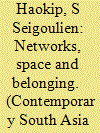

|
|
|
|
|
| Summary/Abstract |
This article aims to supplement existing economic analyses of the Marwari mercantile network by exploring how the network is both grounded spatially and reproduced culturally in Manipur. It discusses some of the economic and socio-cultural practices adopted by the Marwari merchants in Manipur including their business activities, marriage patterns and temple construction. In so doing, it highlights the nature of relationships between these practices and how they are connected to their mercantile network at large. The article also illustrates how merchant communities such as the Marwaris carve out their own space through cultural processes of place-making in a contested place like Manipur. Elucidating how the Marwari mercantile network gets reproduced culturally, it reveals the ways in which networks of capital relate to distinct spatial configurations – in this case, borderland. In turn, the above process also delineates how the idea of belonging for the Marwari merchants is emplaced and shaped at the same time by their mercantile network. Based primarily on interviews, observation and some documents, the materials used in this article stem mainly from Imphal and some from Churachandpur.
|
|
|
|
|
|
|
|
|
|
|
|
|
|
|
|
| 3 |
ID:
192857
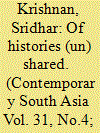

|
|
|
|
|
| Summary/Abstract |
While much has been written about how imperialist and Indian nationalist historiographies have approached 1857, scant attention has been paid to how it has been remembered in Pakistan. This article endeavours to explore the ways in which 1857 has been articulated by the state in India and Pakistan through a study of their commemorative postage stamps. On the face of it, India's emphasis on nonviolence and Pakistan's quest for an Islamic history make 1857 a misfit within the historiographies of both states. However, the paper outlines that during the centenary in 1957, both India and Pakistan commemorated 1857 while maintaining some discursive distance from it. While Pakistan chose to memorialise it as the beginning of its struggle for independence, India recessed it within the broader framework of independence itself. The paper goes on to demonstrate how this position has changed drastically over the years. In order to weave a composite and inclusive history of the country, India now celebrates the legacy of 1857 by appropriating it within the frames of national unity, patriotism, and anti-imperialism. Pakistan, on the other hand, uses 1857 merely as a means to segue into a discussion of reform efforts led by the subcontinent's Muslim elite, thereby relegating it to the background of the Pakistan movement.
|
|
|
|
|
|
|
|
|
|
|
|
|
|
|
|
| 4 |
ID:
192858
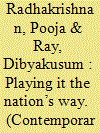

|
|
|
|
|
| Summary/Abstract |
The generic popularity of Hindi sports films has been overwhelming in recent years. The article examines this genre of Hindi films through the thematic construction of the sports‘man’ and its evolutionary manifestation from a masculine figure symbolising India’s national unitarian ethos to a megalithic, tradition-backed, orthodox patriarchy post-2010s. It elaborates this seemingly linear transformation through decade based phases, starting from the social-emancipatory athletic phenomenon of the pre-globalisation era to the neoliberal Hindi sports films of the early millennial phase. The study then explores the slow dissolution of the ‘composite masculinity’ that considered the ethnic variegation of Indian nationalism, and the emergence of sporting cinema on patriarchal and athletic superheroes. The article further discusses how it was nurtured within deeply insular, and ethno-religious gaming traditions of antiquity like the akhara wrestling, in fictional/biographical sports films like Sultan (Zafar 2016) and Dangal (Tiwari 2016). While commenting on this transformation of the ‘national athlete’ into the ‘heritage’s surrogate’, the article attempts to provide a detailed methodology of understanding the expanding canon of Hindi sports films so far and how it aligns itself with the re-ethnicisation of India’s polity in the last two decades.
|
|
|
|
|
|
|
|
|
|
|
|
|
|
|
|
| 5 |
ID:
192862
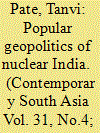

|
|
|
|
|
| Summary/Abstract |
Conventional wisdom on India’s nuclear geopolitics takes a top-down approach, foregrounding state perceptions of India’s nuclear role in regional and global politics. This conventional approach overlooks the bottom-up processes, such as media representations, which have been fundamental in shaping India’s nuclear identity. This is because media representations comprise common-sense knowledge, since media is the primary source of information in a democracy. Building on theoretical underpinnings of popular geopolitics, this article focuses on analyses of media representations in the Editorial of the English daily The Hindu from 2011–2020. This national newspaper boasts the second-largest readership among English dailies. The direct link between The Hindu Editorial’s representations of ‘nuclear India’ and India’s ‘regional’ and ‘global’ selfhood is crucial. The concerned period of 2011–2020 was pivotal in charting Indian geopolitical identity, as India partook in international negotiations after the US-India Nuclear Deal in 2008 and became a member of multilateral export control regimes like the Wassenaar Arrangement, Australia Group, and Missile Technology Control Regime. This article deconstructs the Editorial texts to elicit the intertextual links underpinning the ‘geopolitical cultural signifier’, ‘geospatial mythology’, and ‘self/other’ binary representation that operationalises India’s nuclear identity in regional and global settings.
|
|
|
|
|
|
|
|
|
|
|
|
|
|
|
|
| 6 |
ID:
192864
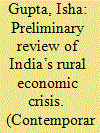

|
|
|
|
|
| Summary/Abstract |
Aggregate growth numbers for India present a positive outlook as its economic momentum builds back and the economy displays full recovery following the Covid-19 crisis. It consequently reflects the Indian economy’s underlying resilience and ability to resuscitate its overall growth, driven by the rebound in private consumption despite the strong global headwinds and widening external deficits. However, its rural economy indicators point to a contradictory set of circumstances since this segment has been afflicted with persistently stagnant real wage growth in agricultural and non-agricultural occupations. It is further accompanied by the pileup of past debt for this section of the population, accumulated in the slowdown years of the post-demonetization phase, which has resulted in a continual weakening of rural consumption demand. The purpose of this research note is to provide a preliminary review of a deep-rooted crisis in India’s rural economy. This crisis is not merely an outcome of Covid-induced and inflationary factors, but rather dates back to the post-demonetization period. The data uncovers an enduring vicious spiral for the rural population group that not only questions the consumption stimulus to growth, but also imperils the resilience and economic prospects of the Indian economy.
|
|
|
|
|
|
|
|
|
|
|
|
|
|
|
|
| 7 |
ID:
192863
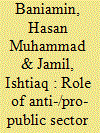

|
|
|
|
|
| Summary/Abstract |
People may evaluate the same level of performance differently because of different biases. The study explores the possible effects of anti-/pro-public-sector bias on perceived performance and fairness in South Asian countries. Using a survey experiment involving a vignette of identical performance (same level of performance) in public and private hospitals, the study finds lower perceived performance in Bangladesh for the public hospitals due to anti-public-sector bias. However, such an effect was not found in other South Asian countries. Rather, the study finds that in India and Sri Lanka, people assessed greater fairness in public hospitals than in private hospitals for the same quality of services. This assessment of fairness may result from pro-public sector bias. Thus, the evaluation of organizational performance can be shaped by sectoral biases, and people may report different levels of performance for identical performance.
|
|
|
|
|
|
|
|
|
|
|
|
|
|
|
|
| 8 |
ID:
192860
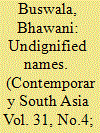

|
|
|
|
|
| Summary/Abstract |
Focusing on the experiences of the marginalised castes in North India, this article examines the use of given names in intercommunity micro interactions and how it shapes the practices of everyday humiliation. With ethnographic data from Dalit activist discourses as well as everyday life in an urbanising village in Rajasthan, this article analyses how the upper castes tend to deform the given names of the members of the Dalit community to produce undignified names, and how the community claims their right to be addressed with appropriate names. I engage with the complexity of the formation and use of undignified names by analysing their function in shaping the local political field to regulate participation in the public sphere and how they are linked to valuable names in the production of social distinctions and their economic benefits. Taking names as an important symbolic object, this article foregrounds the politics of humiliations in everyday intercaste vyavahar to understand the micro dynamics of caste reproduction and how it is negotiated and contested.
|
|
|
|
|
|
|
|
|
|
|
|
|
|
|
|
|
|
|
|
|